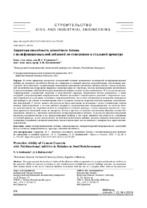Защитная способность цементного бетона с полифункциональной добавкой по отношению к стальной арматуре

Date
2023Publisher
Another Title
Protective Аbility of Cement Concrete with Polyfunctional Additive in Relation to Steel Reinforcement
Bibliographic entry
Гуриненко, Н. С. Защитная способность цементного бетона с полифункциональной добавкой по отношению к стальной арматуре = Protective Аbility of Cement Concrete with Polyfunctional Additive in Relation to Steel Reinforcement / Н. С. Гуриненко, Э. И. Батяновский // Наука и техника. – 2023. – № 4. – С. 278-285.
Abstract
В статье приведены результаты исследований влияния компонентов комплексной полифункциональной добавки на защитную способность бетона по отношению к стальной арматуре железобетонных строительных конструкций. В соответствии с современными тенденциями применения химических добавок в бетон с целью комплексного воздействия как на процессы твердения и формирования его структуры, так и на конечные физико-механические и эксплуатационные свойства бетона рассматриваемая добавка состоит из ряда компонентов. В ее состав входят пластифицирующий, ускоряющий твердение и уплотняющий структуру твердеющего бетона компоненты, а также аморфный ультрадисперсный микрокремнезем. Наличие последнего сопровождается реакцией с гидроокисью кальция и переводом ее в связанное состояние в твердеющем бетоне, что создает предпосылки к понижению щелочности (рН-фактора) в его объеме и соответственно может создавать опасность коррозии стальной арматуры железобетонных конструкций. С учетом данного обстоятельства были выполнены исследования с целью установления степени влияния присутствующего в составе добавки аморфного ультрадисперсного микрокремнезема на свойства бетона, включая оценку его защитных свойств по отношению к стальной арматуре, а также изменение прочности с течением времени (в настоящей статье до «возраста» бетона в три года от момента изготовления образцов составов без химических добавок и с введением комплексной полифункциональной добавки). В результате выявили повышение плотности, прочности бетона и его эксплуатационных свойств, в том числе защитную способность по отношению к стальной арматуре, за счет комплексного воздействия компонентов добавки, включая снижение начального водосодержания, повышение плотности цементного камня и переходных зон его контакта с поверхностью зерен заполнителя в бетоне.
Abstract in another language
The paper presents the results of studies of the influence of the components of a complex polyfunctional additive on the protective ability of concrete in relation to steel reinforcement of reinforced concrete building structures. In accordance with modern trends in the use of chemical additives in concrete with the aim of a complex effect both on the processes of hardening and the formation of its structure, and on the final physical, mechanical and operational properties of concrete, the additive in question consists of a number of components. It consists of a plasticizing component, accelerating hardening and compacting the structure of hardening concrete, as well as amorphous ultrafine microsilica. The presence of the latter is accompanied by a reaction with calcium hydroxide and its transfer to a bound state in hardening concrete, which creates prerequisites for a decrease in alkalinity (pH factor) in its volume and, accordingly, can create a risk of corrosion of steel reinforcement of reinforced concrete structures. Taking into account this circumstance, studies have been carried out in order to establish the degree of influence of the amorphous ultrafine microsilica present in the composition of the additive on the properties of concrete, including an assessment of its protective properties in relation to steel reinforcement, as well as a change in strength over time (in this paper up to the "age" of concrete in three years from the moment of manufacture of samples of compositions without chemical additives and with the introduction of a complex polyfunctional additive). As a result, an increase in the density, strength of concrete and its operational properties, including the protective ability in relation to steel reinforcement, due to the complex effect of the additive components, has been revealed, including a decrease in the initial water content and an increase in the density of the cement stone and transition zones of its contact with the surface of the aggregate grains in concrete.
View/
Collections
- № 4[10]
